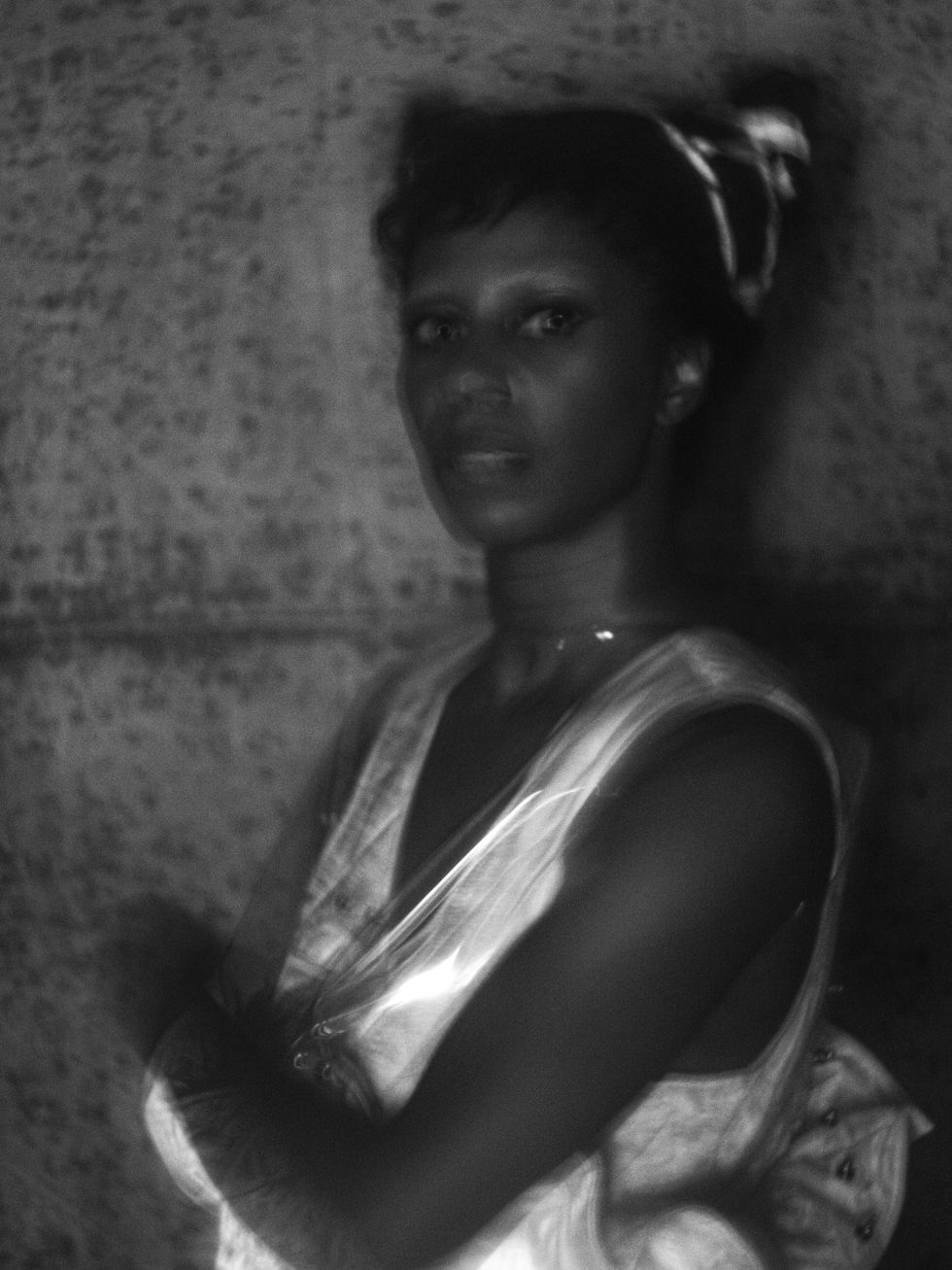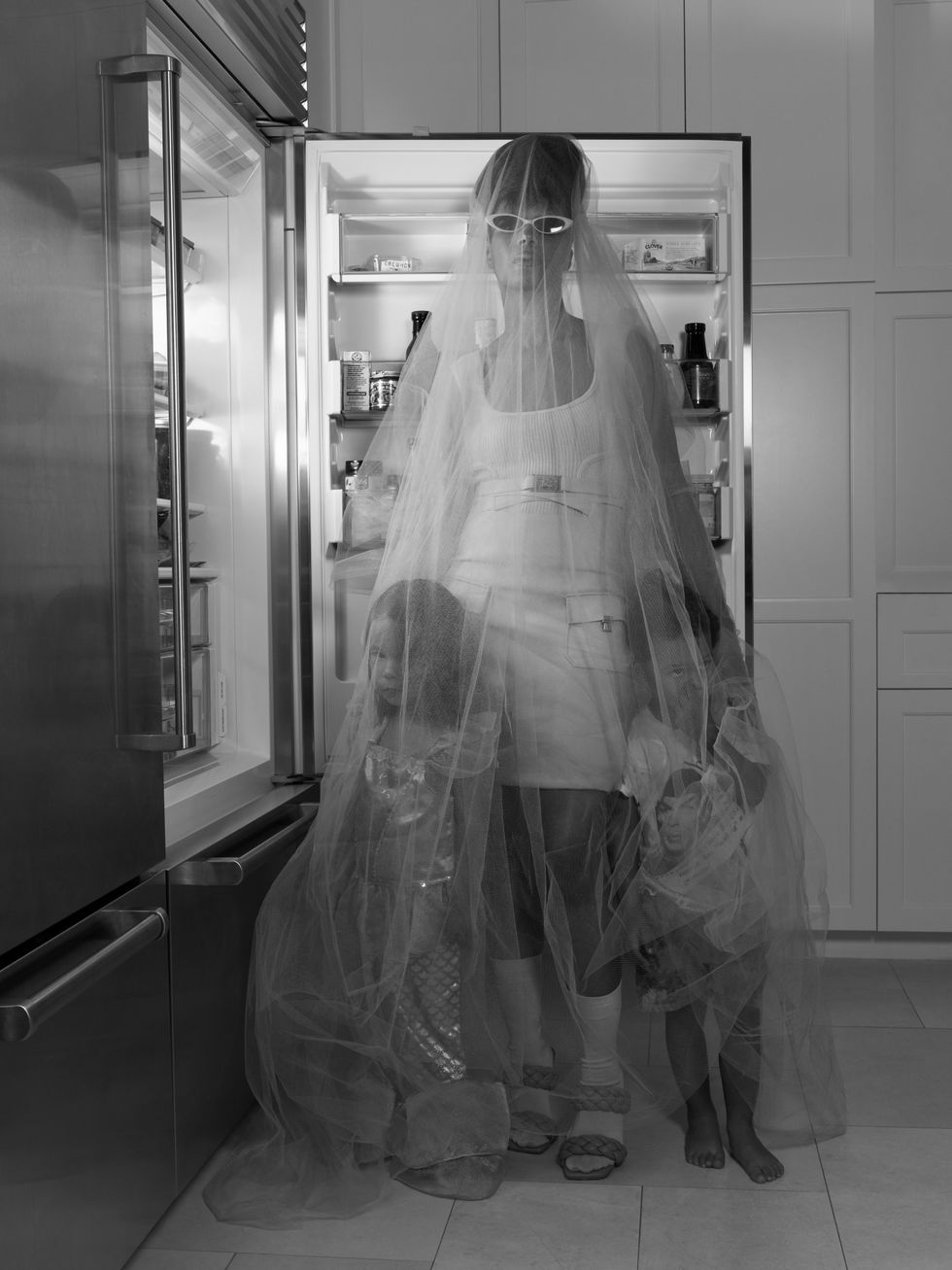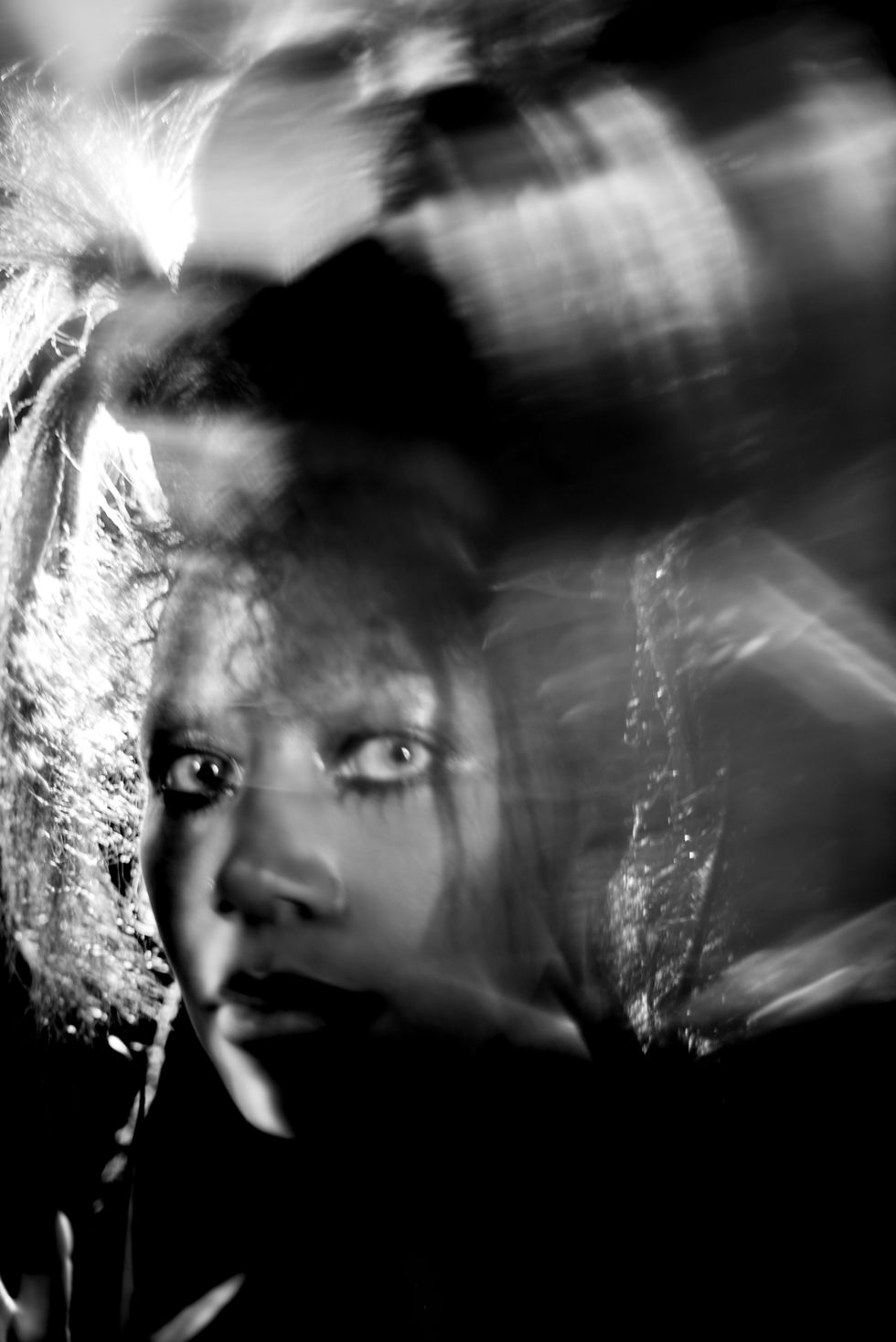Much like you, Santigold spent the pandemic stuck at home, fearful of an invisible threat that loomed just outside her door, the world burning around her, quite literally. California was ablaze with wildfires, Black Lives Matter protests erupted in response to constant headlines featuring Black people dying and Santigold was in the middle of it all taking care of her three children at home, feeling the artist side of her diminishing as the banality of domestic routine took over.
With no end in sight, Santigold found comfort in negro spirituals — songs used by the slave population as a way to persevere and find existential freedom in the face of hardship. Santigold drew inspiration from the concept as a way to make sense of chaos. Having grappled with a total writer's block just before the pandemic hit, suddenly Santigold found lyrics pouring out of her faster than before. Instead of wallowing in the miserable present, she imagined a beautiful future to strive towards that was as much for her as it was for anyone else that needed it.
The resulting album, Spirituals, is a collection of roaring anthems, mournful elegies, bubbly pop and folk stomps that finds feelings of joy and resilience amongst overwhelming grief and despair. From the island breeze swirling through the emotional spiral of opener "My Horror" to the screaming guitars and defiant confidence of "High Priestess," Santigold takes us through the highs and lows of her pandemic struggle.
Featuring contributions from frequent collaborators such as Rostam, Boys Noize and Illangelo, as well as a few new faces like SBTRKT and Lido, Spirituals runs the gambit from haunting industrial beats to warm indie blitzes, sprinkled with crystalline synths and vibrant vocal flourishes. After nearly a decade and a half spent honing her pop sensibilities, Santigold's voice and distinct point of view emerge as the common denominator that makes the album feel cohesive overall.
Never one to be satisfied with confining her creative vision, the world of Spirituals extends outward into a full-on multi-sensory experience: music and video vignettes, visual art, a line of natural body care products and teas, a new podcast interviewing other artists and luminaries, as well as a bunch of other yet to be announced endeavors.
At its crux, Spirituals is about what it takes to survive in an unforgiving world. Digging through a mountain of collective trauma to unearth some form of relief, Santigold finds solace and release through shared strife. Forged in the fires of the pandemic, Spirituals is Santigold's best stab at some semblance of catharsis — a soothing balm when it needs to be, a shoulder to cry on, a hand reaching out to pick you back up, a hammer to break shit and a bullhorn to amplify your primal screams.

Before the release of Spirituals, out September 9, PAPER caught up with Santigold to dive into making her latest album and what she ultimately hopes people can take away from it.
How did the new album start and end up coming together?
It started with me saying, "Hey, I think I’ll make a new album!" This was back in 2019, looking over some of the stuff I’ve been working on with various people over the last year or so and thinking about which things might go together. I sat down and started trying to write some songs and I had nothing to say. I was like, "Huh, I don’t know. Maybe I just don’t have anything to say!"
Then all of a sudden the pandemic hit and we’re on lockdown, and I was stuck in my house with my just-turned two-year-old twins and my six-year-old at the time, and no help from my husband. All of a sudden I was just cooking and cleaning and wiping butts and hiding from this disease that we didn’t know what it was and what it was going to do. Then California was on fire and Black people were getting killed every second and there were protests. I just somehow found myself sat with those songs, and everything just poured out so fast. That’s how I got my record!
What was the recording process along the way for you? What sort of ideas and things were you tackling?
I actually recorded by myself in a room but with an engineer recording me using all my equipment from afar. It was just a testament to technology that it was able to happen where I could have my engineer recording me from my studio without being physically with me during lockdown, which I thought was cool!
When it got into finishing the songs and finishing the production, by that time, my family had gone off to Canada. We were in this place called Squamish, which is in between Vancouver and Whistler, I had rented a cabin in the woods and sent all my music equipment out. I was actually working with a bunch of producers all over the world virtually.
Yeah, it’s quite the lineup of producers looking through the credits! How did all of those come into play? Was that just calling up old friends or were there new faces in the mix?
Like I said, right before I started, I had done some writing sessions in 2019 right before the pandemic. It wasn’t even for my album necessarily, but I just got in with some new producers. I met SBTRKT for the first time probably a month before the pandemic really hit. We actually got together for some stuff on his album but I ended up with some stuff for my album instead.
I met P2J, who I did “No Paradise” with, and I had never met him before. Dre Skull, I had done that whole mixtape album with him before. Boys Noize I’d known for years. Rostam I’d worked with for years. Ricky Blaze I worked with, who did “Disparate Youth” with. Lido was another person that was new that I had just gone in with and ended up using a song. JakeOne I had never met before.
So that was cool to have new people and it’s always great to find new people that you work really well with because I tend to keep people around — like I said, Rostam or Boys Noize, or Doc [McKinney] of course. Doc I’ve been writing with since 2001. Illangelo, I had actually met through Doc. It’s a mixture of people I’ve worked with for years and years and a bunch of new people I’d never worked with before.
Thematically for the album, obviously in the title is “Spirituals.” What were some of the ideas you were playing with?
The title of the album I got from the idea of negro spirituals and what they did. The purpose of negro spirituals is that they allowed slaves to experience feelings of freedom and joy when they weren’t actually free and they weren’t in joyous circumstances. They were songs that let them transcend their environment and circumstances. That’s what these songs did for me. They are in no way traditional negro spirituals at all, but the purpose of the songs — they allowed me to transcend my circumstances and my environment to feel ascension, forward movement and to create beauty and light and joy to move towards in a time that did not feel beautiful, light, and joyous.
I love the parallels between that! Was there any moment along the way that stood out to you as a catalyzing point or that stood out to you along the way?
I think this record in particular, we were in a time in the world where I didn’t have any expectations. I didn’t know what was going on. Day to day, there was some crazy new shit going on. I was just doing what I could to get through it. Every step of the way was unexpected. The creation of this record was just a little bit about flow. That’s what “Shake” is about — just moving! Letting your feelings flow, the emotions flow so you can continue on and go with whatever comes. That’s what I learned during the process of this record — just letting my creativity carry me through.

What do you hope people take away from the album?
There are so many things in this record that people can take away from it. Connecting inward through times that are challenging and find a higher connection or a higher force and really help that to pull you forward. The idea that we all have that in ourselves. The idea of us being responsible for the world we create like “Ushers of the New World.” We need to be present in our connection to each other and the earth and live in a harmonious way. The idea of human resilience and our continual strength and power to rise above our circumstances. I have a lyric in “No Paradise” — “there’s power in our struggle.” The idea of nothing — what it’s like to be a Black person or a woman and to feel unseen and to be told that we don’t matter and to feel invisible. There’s a lot of important themes in this music that I’d like people to think about and feel empowered to explore.
Outside of your new album, you have a lot going on. You’re working on a natural skincare line and tea!
I really was thinking about how people can experience the music and themes that I’m talking about, since I was talking about spirits and emotions, if I could touch on them from a multisensory standpoint. if you could not only listen to the songs but also touch something and watch something and taste something and smell something. That all speaks on the same themes and experiences and affects your spirit in the same way.
For instance, one of the things I was thinking about was survival and being in survival mode. Black people are pretty much always in survival mode in this country. Part of that is generational trauma and stuff that we’re carrying from our ancestors' experiences. How can we begin to free ourselves of the things we’re carrying that aren’t really ours to carry?
I’ve always been into oils and herbs and teas, so I know that black spruce is an ingredient that deals with your roots and generational trauma and helps clear that energy. So I was like, “let me make a body spray with black spruce” for example! Or “let me make a tea that helps deal with clearing your heart or stop having all this stuff Black women carry in our chests.” That’s really the inspiration for the idea. It’s not really a skincare line. It’s more like small batch body products that I made to go with the album.
And tea! I love tea so much. I tried to make a collection of tea that was really unusual, and relevant to themes, but really special teas that you wouldn’t always have.
Fitting in with the themes of the record, there’s a nice ritual aspect to tea.
Exactly! And whether it’s a ritual like a tea ceremony or you could have a bath with bath salts with tea and listen to a song. It’s just coming at you from so many different angles.
How are you going about translating the record into the live show and putting it into the physical space?
In general, I like to come up with a show that really takes a song and turns them into a physical experience. It’s not just me singing the songs. I take you into a whole different world. I usually try to come up with visuals and dance and costumes that make you feel like you’re just coming into a whole new experience of the music.
I remember for 99¢, it was very much about consumption and commodification of everything. I had the dancers come out and sit in a blow up chair and eat cheap foods and drink Slurpees for the first ten minutes as their choreography. It’s just fun to get to play with the themes and ideas in a different way that has nothing to do with music, but you can really create in a whole different way when you’re doing a live show, so I’m always looking forward to that!
Photos courtesy of Frank Ockenfels
- Artists React to Name Checks on Beyoncé' and Madonna's 'Break ... ›
- Santigold — "Shake" - PAPER ›
- Santigold Wants More - PAPER ›
- Santigold Cancels 'Holified Tour' ›
